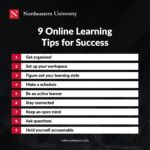Understanding your learning style can be a valuable tool for maximizing your academic and personal growth. While the concept of “learning styles” as fixed traits has been debunked by research, understanding your learning preferences can significantly enhance your learning experience. This article explores the difference between learning styles and preferences, examines the popular Solomon-Felder model, and offers practical strategies to optimize your learning based on your individual preferences.
Learning Styles vs. Learning Preferences: A Crucial Distinction
The idea of learning styles gained popularity in the 1970s, suggesting individuals learn best through specific sensory modalities (visual, auditory, or kinesthetic). However, scientific evidence overwhelmingly suggests that tailoring instruction to these perceived styles doesn’t improve learning outcomes. Instead, focusing on learning preferences, which are the ways individuals naturally gravitate towards processing information, offers a more practical approach. These preferences are not fixed but can adapt based on context and experience.
The Solomon-Felder Model: A Framework for Understanding Preferences
The Solomon-Felder model provides a comprehensive framework for understanding learning preferences. It categorizes learners along four dimensions:
1. Active vs. Reflective: How Do You Process Information?
- Active learners prefer to engage with information through discussion, experimentation, and application. They learn by doing.
- Reflective learners prefer to contemplate information internally before taking action. They learn by thinking things through.
2. Sensing vs. Intuitive: How Do You Perceive Information?
- Sensing learners prefer concrete, practical information with a focus on facts, details, and established procedures.
- Intuitive learners prefer abstract concepts, theories, and the big picture. They enjoy discovering patterns and possibilities.
3. Visual vs. Verbal: How Do You Prefer Information to be Presented?
- Visual learners prefer diagrams, charts, images, and other visual aids.
- Verbal learners prefer written and spoken explanations.
4. Sequential vs. Global: How Do You Organize Information?
- Sequential learners prefer a linear, step-by-step approach to learning.
- Global learners prefer a holistic approach, often grasping the big picture before understanding the details. They may seem disorganized but often arrive at creative solutions.
Leveraging Your Learning Preferences: Strategies for Success
Understanding your preferred learning modes empowers you to adopt strategies that optimize your learning:
- Active Learners: Engage in discussions, apply concepts through projects, and seek opportunities for hands-on learning.
- Reflective Learners: Allocate time for quiet reflection, summarize material in your own words, and connect new information to prior knowledge.
- Sensing Learners: Look for practical applications of concepts, focus on concrete examples, and break down complex information into smaller parts.
- Intuitive Learners: Explore underlying theories, connect ideas to broader contexts, and engage in brainstorming and creative problem-solving.
- Visual Learners: Use diagrams, mind maps, and visual aids to organize information, watch videos, and utilize color-coding techniques.
- Verbal Learners: Write summaries, participate in discussions, and explain concepts aloud to solidify understanding.
- Sequential Learners: Organize material in a logical order, break down tasks into smaller steps, and follow a structured learning plan.
- Global Learners: Start with the big picture, look for connections between different concepts, and embrace a more flexible learning approach.
Conclusion: Embracing a Personalized Approach to Learning
While adhering to rigid learning styles is ineffective, understanding your learning preferences can significantly improve your learning experience. By identifying your preferred modes of processing and organizing information, you can tailor your study habits and learning strategies to maximize comprehension and retention. Remember that learning preferences are dynamic and can evolve over time. Embrace experimentation and self-reflection to continuously refine your approach to learning and unlock your full potential. The Solomon-Felder model and the strategies outlined above provide a valuable starting point for this journey of self-discovery and academic success.
